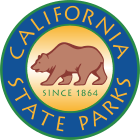California Department of Parks and Recreation facts for kids
The California Department of Parks and Recreation, also known as California State Parks, is in charge of California's amazing system of state parks. This system looks after 280 different park areas. These parks cover a huge 1.4 million acres (about 570,000 hectares). They include over 280 miles (450 km) of beautiful coastline and 625 miles (1,000 km) of lake and river shores. You can find nearly 15,000 campsites and 3,000 miles (4,800 km) of trails for hiking, biking, and even horseback riding!
The main office for California State Parks is in Sacramento. The parks are managed by 21 different local districts. Did you know that California State Parks is the biggest state park system in the entire United States?
Contents
History of California State Parks
California's very first state park was the Yosemite Grant. Today, this area is part of the famous Yosemite National Park. In 1864, the U.S. government decided to protect Yosemite Valley. They gave this land to California to manage until 1906.
California's oldest park that is still a state park today is Big Basin Redwoods State Park. It was created in 1902. For many years, each park was managed by its own separate group.
How the Park System Grew
In 1927, California's government decided to create one main group to manage all state parks. This group was called the State Park Commission. Important people like Governor C. C. Young supported this idea.
The next year, in 1928, the new State Park Commission asked Californians to vote on a plan to raise money for parks. People voted almost three-to-one in favor of spending $6 million to buy more park land. Also, a special plan was made by Frederick Law Olmsted Jr. to help guide where new parks should be and how they should grow. With help from people like Newton B. Drury, the state park system quickly started to get bigger.
Challenges and Changes for Parks
Sometimes, state parks face challenges, especially with money. In 2008 and 2011, there were times when some parks were considered for temporary closure due to budget problems in California. However, often ways were found to keep them open, sometimes by reducing services or finding other solutions.
Later, a group called the Parks Forward commission was created. This group looked at how the parks were being managed. In 2015, they suggested ways to improve things. They noted that some parks needed more maintenance and that the park system could use newer technology for things like managing reservations. They also wanted to make sure the parks welcomed visitors from all different backgrounds in California.
There were also some financial discoveries within the department in 2012. These discoveries led to changes in leadership to help improve how the park system's money was managed.
What California State Parks Protects
California State Parks looks after almost one-third of California's beautiful coastline, which is about 280 miles long. They manage the state's best coastal wetlands, estuaries, beaches, and dune systems.
The California State Parks system protects the largest and most varied collection of natural and cultural treasures of any state agency in the country. Our state park units include:
- Underwater preserves and parks
- Amazing redwood forests and wildlife areas
- Beautiful state beaches and recreation areas
- Wilderness areas and reservoirs
- Important state historic parks, old homes, and Spanish-era adobe buildings
- Museums, visitor centers, and cultural sites
- Lighthouses, caverns, and even ghost towns!
These parks work hard to protect and save special places. This includes sensitive natural areas, plants and animals that are in danger, ancient Native American sites, and historic buildings and objects.
Park Protectors
The Department employs special people called State Park Peace Officers. These officers are like law enforcement for the parks. They protect the parks and the millions of people who visit them every year. These officers include State Park Rangers and State Park Lifeguards.
Types of State Parks
The places managed by the California Department of Parks and Recreation are grouped into different types. Here are some of them:
- 87 State Parks
- 63 State Beaches
- 51 State Historic Parks
- 32 State Recreation Areas
- 16 State Natural Reserves
- 14 State Park Properties
- 8 Vehicular Recreation Areas (for off-highway vehicles)
- 2 State Marine Reserves
- 1 State Historical Monument
- 1 State Seashore
- 1 Wayside Park


